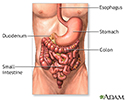Bowel transit time
Bowel transit time refers to how long it takes for the food to move from the mouth to the end of the intestine (anus).
This article talks about the medical test used to determine bowel transit time.
How the Test is Performed
You will be asked to swallow 2 gelatin capsules filled with a colored food dye. You take these capsules with a meal.
Afterwards, you observe your bowel movements and write down how long it takes for the colored dye to first appear. You will also need to note how long it takes for the color to disappear from the stools.
How to Prepare for the Test
In most cases, you DO NOT need to prepare for this test. However, you should follow any diet or other directions from the health care provider.
How the Test will Feel
You will not feel the capsules move through your digestive system.
Why the Test is Performed
The test helps determine bowel function.
Your provider may ask you to record transit times as you introduce fiber into your diet. Your diet affects the bowel transit time. For example, if you eat a lot of foods rich in fiber (whole grains, vegetables, and fruits), you will have a more rapid transit time and a heavier, bulkier stool.
Fiber
Fiber is a substance found in plants. Dietary fiber, which is the type of fiber you can eat, is found in fruits, vegetables, and grains. It is an i...

Normal Results
The bowel transit time varies, even in the same person. The color should first appear in the stool about 12 to 14 hours after it is taken. The last of the color will appear within 36 to 48 hours.
What Abnormal Results Mean
If the transit time is 72 hours or more, you may have slowed bowel function.
Risks
There are no risks.
Considerations
The bowel transit time dye test is rarely done these days. Instead, bowel transit is often measured with small probes called manometry. Your provider can tell you if this is needed for your condition.
References
Andrews JM, Brierley SM, Blackshaw AL. Small intestine motor and sensory function and dysfunction. In: Feldman M, Friedman LS, Brandt LJ, eds. Sleisenger & Fordtran's Gastrointestinal and Liver Disease . 10th ed. Philadelphia, PA: Elsevier Saunders; 2016:chap 99.
Camilleri M. Disorders of gastrointestinal motility. In: Goldman L, Schafer AI, eds. Goldman's Cecil Medicine . 25th ed. Philadelphia, PA: Elsevier Saunders; 2016:chap 136.
-
Lower digestive anatomy - illustration
Food passes from the stomach into the small intestine. In the small intestine all nutrient absorption occurs. Whatever has not been absorbed by the small intestine passes into the colon. In the colon most of the water is absorbed from the food residue. The residue is then eliminated from the body as feces.
Lower digestive anatomy
illustration
-
Lower digestive anatomy - illustration
Food passes from the stomach into the small intestine. In the small intestine all nutrient absorption occurs. Whatever has not been absorbed by the small intestine passes into the colon. In the colon most of the water is absorbed from the food residue. The residue is then eliminated from the body as feces.
Lower digestive anatomy
illustration
Review Date: 7/22/2016
Reviewed By: Subodh K. Lal, MD, gastroenterologist with Gastrointestinal Specialists of Georgia, Austell, GA. Review provided by VeriMed Healthcare Network. Also reviewed by David Zieve, MD, MHA, Isla Ogilvie, PhD, and the A.D.A.M. Editorial team.

